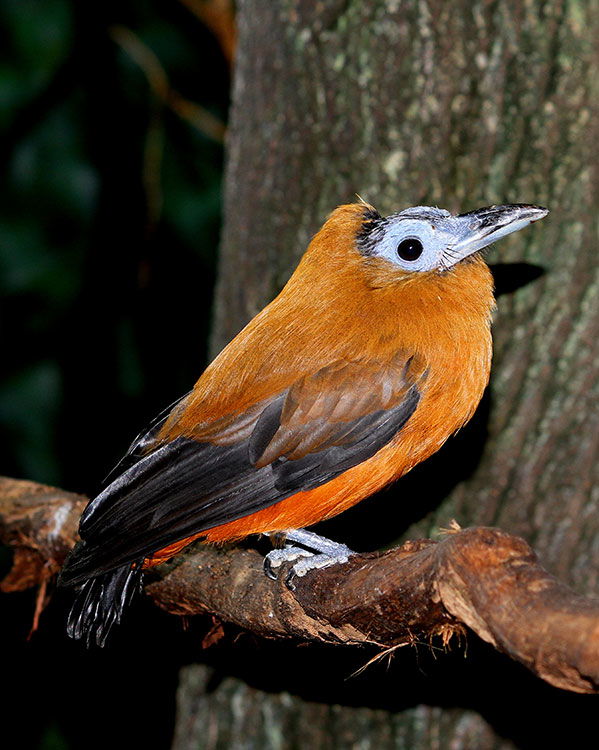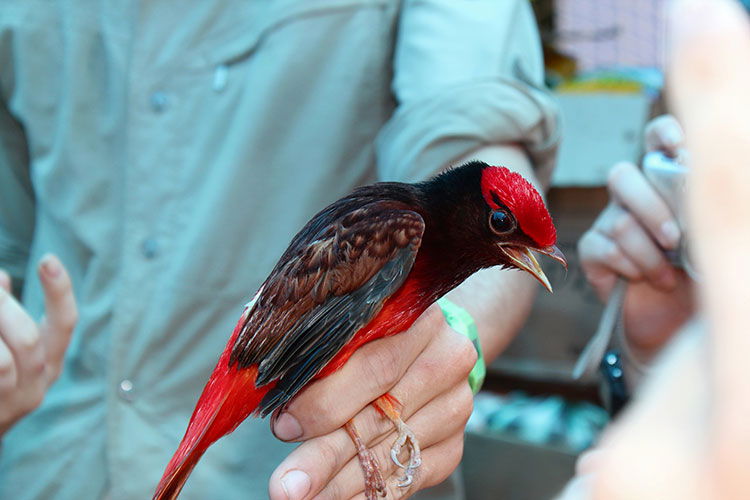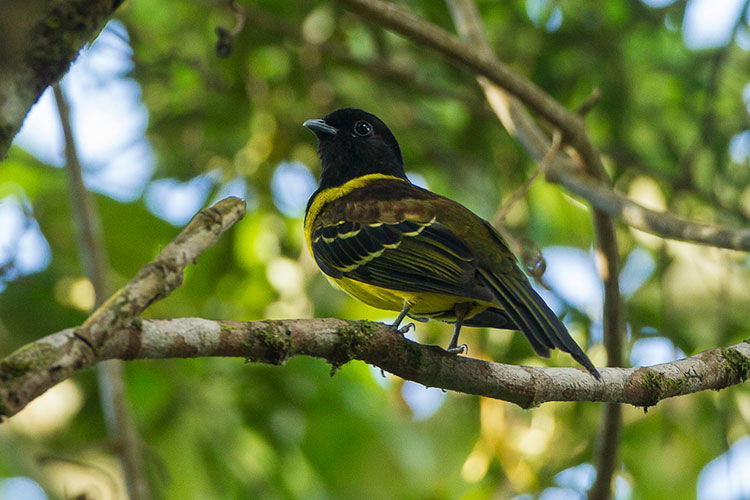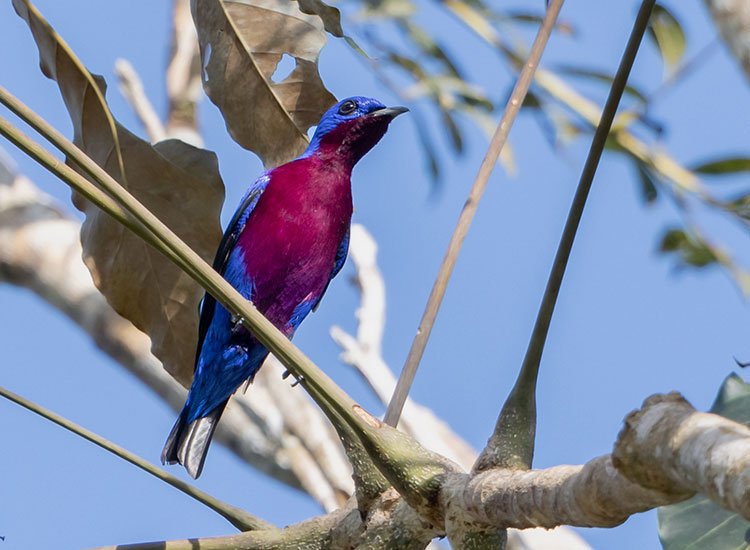Colorful Birds
Greg Hume, CC BY-SA 3.0, via Wikimedia Commons
Cotingidae
by Inspector Barry Mins on November 7, 2023Hey kids, welcome back to our series on the mysteries of created kinds. Before we meet this week’s kind, I want to announce the winner of our “name the cormorant” poll.
Around 47 of you voted, and none of the names received a clear majority. However, the top three were well ahead of the bottom three. From third to first, the top three were:
- Mephibosheph
- Flappy
- Cormelius
Therefore, our cormorant will be known as Cormelius! Thanks to everyone who voted—we will keep you posted on how Cormelius is doing from time to time.
This week, we move into South America to look for a large group of colorful birds.
Many members of this kind have exciting and bold colors. Some of these colors come directly from proteins, while others require a complex interaction of pigments, nearby proteins, and the structure of the feathers.1 Members of this kind vary wildly in their habitat use, from mangroves to lowland forests.2 Some will live in logging areas,3 while others will even use recently burned-out forests.4 Some migrate to high altitudes to breed and return to lower altitudes for the rest of the year.5
Members of this kind are largely frugivores, meaning they eat mostly fruit. One study documented nearly 100 different fruits that members of this kind consumed.6 However, some members of the kind vary their diet by taking in the odd vertebrates.7 Others will munch on insects fleeing army ants.8 Others completely reject any animal matter but consume leaves in large quantities.9 The frugivores often serve as useful seed dispersers for the plants they eat.10
Many of these species are sexually dimorphic, meaning males and females do not look alike. Males often compete for female attention on a lek, a special breeding ground where males assemble. In at least one genus of this kind, males will deliver a meal to the female, and the female will select a mate based on how good the meals are.11 Others merely sing to attract females.12 When on the lek, males will perform complex courtship displays accompanied by sounds and songs.13
Once a male has a mate, a nest is built, usually by the female.14 Often, the nest is built of small sticks from shrubs and trees.15 Other species make their nests of lichen.16 The nest is often built in a forked tree branch or other gap in the foliage, and one to two eggs are laid.17 In some species, the females incubate alone.18 The females also provide the food and care for the nestling.19 Females go to extreme lengths to avoid the nest being discovered, often flying to several trees or hopping along the ground before flying to the nest. They will even eat the baby birds’ excrement to avoid it being found by a nest-hunter.20
Has anyone figured it out yet? This week’s kind is the Cotingidae —the Cotinga kind. These gorgeous birds are found throughout Central and South America, wherever there are patches of trees. Stay tuned for next week when we meet a strange group of mammals.
Try out this fun crossword!
Clue
Your clue for the week is:
Members of this kind are often classified based on special scent glands, but they are not skunks.
Ask a Question
Have you ever had a question about created kinds but didn’t know who to ask? Have you ever wanted to learn more about your favorite kind? Well, now you can! You can ask me, Inspector Barry Mins, a question! Have your parents help you fill out this form, and you might get your question answered in my column! If you have any questions about created kinds, feel free to send them my way!
Footnotes
- A. M. LaFountain, S. Kaligotla, S. Cawley, K. M. Riedl, S. J. Schwartz, H. A. Frank, and R. O. Prum, “Novel methoxy-carotenoids from burgundy-colored plumage of the Pompadour Cotinga Xipholena punicea,” Archives of Biochemistry and Biophysics 504, no. 1 (2010): 142–153, https://www.ncbi.nlm.nih.gov/pmc/articles/PMC3887449/.
- K. M. Leavelle, L. L. Powell, G. V. N. Powell, and A. Forsyth, “A radio-telemetry study of home range and habitat use of the endangered yellow-billed cotinga (Carpodectes antoniae) in Costa Rica,” The Wilson Journal of Ornithology, 127, no. 2 (2015): 302–309, https://www.researchgate.net/profile/Luke-Powell-6/publication/281130063.
- O. Jahn, E. E. Vargas Grefa, and K. L Schuchmann, “The life history of the long-wattled umbrellabird Cephalopterus penduliger in the Andean foothills of north-west Ecuador: leks, behaviour, ecology and conservation,” Bird Conservation International 9 (1999): 81–94, https://www.cambridge.org/core/services/aop-cambridge-core/content/view/3D01DEC7B2DFFF1CD535ED7545A32B31/S0959270900003373a.pdf.
- L. A. M. Mestre, J. Barlow, G. Thom, and M. A. Cochrane, “Burned forests as a novel habitat for the black-faced cotinga (Conioptilon mcelhennyi) in the western Brazilian Amazon,” Ornithologis Neotropical 20 (2009): 467–470, https://www.researchgate.net/profile/Luiz-estre/publication/286356886.
- J. Chaves-Campos, J. Edgardo Arevalo, and M. Araya, “Altitudinal movements of bare-necked umbrellabird Cephalopterus glabricollise of the Tilaran Mountains, Costa Rica,” Bird Conservation International, 13 (2003): 45–58, https://www.cambridge.org/core/services/aop-cambridge-core/content/view/7EAE51E4E49D7BE717C4B243AC9A8BAF/S0959270903003046a.pdf.
- M. A. Pizo, W. R. Silva, M. Galetti, and R. Laps, “Frugivory in cotingas of the Atlantic Forest of southeast Brazil,” Ararajuba 10, no. 2 (2002): 177–185, https://repositorio.unesp.br/server/api/core/bitstreams/e2b4d388-a607-4ea4-b111-edbcb332c351/content.
- L. Mahecha, N. Villabona, L. Sierra, D. Ocampo, and O. Laverde-R, “The Andean cock-of-the-rock (Rupicola peruvianus) is a frugivorous bird predator,” The Wilson Journal of Ornithology 130, no. 2 (2018): 558–560, https://www.researchgate.net/profile/Oscar-Laverde/publication/325935728.
- J. Chaves-Campos, “Bare-necked umbrellabird (Cephalopterus glabricollis) foraging at an unusually large assemblage of army ant-following birds,” Wilson Bulletin 117, no. 4 (2005): 418–420.
- E. H. Bucher, D. Tamburini, A. Abril, and P. Torres, “Folivory in the white-tipped plantcutter Phytotoma rutile: seasonal variations in diet composition and quality,” Journal of Avian Biology 34 (2003): 211–216.
- A. Parrado-Rosselli, and J. D. Amaya-Espinel, “Feeding behavior of purple-throated fruitcrow (Querula purpurata: Cotingidae) in the Colombian Amazon and its implications for seed dispersal,” Biotropica 38, no. 4 (2006): 561–565.
- F. I. De Godoy, A. M. Montanhini, and F. Schunck, “New information on the courtship feeding behavior of cotingas of the genus Carpornis from Brazil,” Ornitologia Neotropical 33 (2022): 177–181, https://fabioschunck.com.br/site/wp-content/uploads/2023/04/Godoy-et-al_2022.pdf.
- D. F. Lane, “First description of song display and other notes on the bare-necked fruitcrow (gymnoerus foetidus, cotingidae),” Ornitologia Neotropical 14 (2003): 491–497, https://sora.unm.edu/sites/default/files/journals/on/v014n04/p0491-p0498.pdf.
- B. Lopez-Lanius, “Display and mechanical sound in dusky piha Lipaugus fuscocinereus,” Cotinga 13 (2000): 44–45, https://www.neotropicalbirdclub.org/wp-content/uploads/2016/02/Cotinga-13-2000-44-45.pdf.
- R. A. Gelis, H. F. Greeney, M. Cooper, and C. Dingle, “The nest, eggs, nestlings and fledglings of fiery-throated fruiteater Pipreola chlorolepidota in north-east Ecuador,” Cotinga 26 (2006): 10–12.
- S. Nolazco, and A. M. Sanchez, “Flexibility in resource selection for foraging and next construction in Peruvian plantcutters,” The Wilson Journal of Ornithology 130, no. 2 (2018): 548–554, https://www.researchgate.net/profile/Sergio-Nolazco/publication/325942594.
- G. Bromfield, W. N. Ritchie, V. Bromfield, J. Ritchie, and A. B. Hennessey, “New information on plumage, nesting, behaviour and vocalisations of the Bolivian swallow-tailed Cotinga Phibalura flavirostris boliviana from the Apolo area of Madidi National Park, Bolivia,” Cotinga 21 (2004): 63–67, https://www.neotropicalbirdclub.org/articles/21/Bromfield.pdf.
- F. B. R. Gomes, G. A. Leite, and C. B. Andretti, “Notes on nest and chicks of the Guianan red cotinga (Phoenicircus carnifex) in Amazonas Brazil.” The Wilson Journal of Ornithology 127, no. 3 (2015): 521–523, https://www.researchgate.net/profile/Felipe-Gomes-11/publication/283005137.
- E. O. Willis, and Y. Oniki, “One-parent nesting in cinnamon-vented pihas (Lepaugus lanioides, Cotinginae, Tyrannidae),” Ornitologia Neotropical 9, (1998): 129–159, https://www.researchgate.net/profile/Edwin-Willis/publication/252156286.
- T. B. Smith, J. Karubian, G. Castaneda, J. F. Freile, R. T. Salazar, and T. Santander, “Nesting biology of a female long-wattled umbrellabird Cephalopterus penduliger in north-western Ecuador,” Bird Conservation International 13 (2003): 351–360, https://www.cambridge.org/core/services/aop-cambridge-core/content/view/9F35A4D48C1CEF25585AECDE5D9875E6/S0959270903003253a.pdf.
- H. F. Greeney, G. M. Kirwan, and E. T. Miller, “Nesting biology of the long-wattled umbrellabird Cephalopterus penduliger. Part II: nestling provisioning,” Cotinga 34 (2012): 23–27, https://www.neotropicalbirdclub.org/wp-content/uploads/2015/03/C34-Greeney2.pdf.
- © 2024 Answers in Genesis
- Privacy Policy
- Contact
- About





